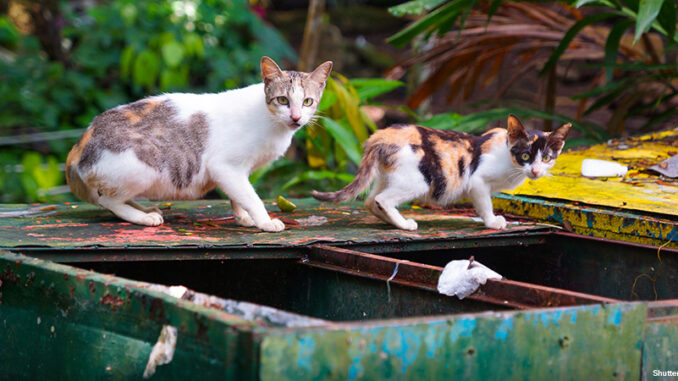
Dancing in the Street
One of the most interesting developments to come out of the COVID-19 crisis is the effect that social distancing has had on the environment. All over the world, as businesses shut down and traffic disappears, cities have seen decreasing levels of air pollution and improved water quality. But that’s not all. Some wildlife species have also begun to reclaim their territory.
In Brazil, sea turtles are able to hatch on the closed beaches without fear of being disturbed by people or pets. There are mountain goats cruising the streets in a town in Wales, peacocks roaming Mumbai neighborhoods, deer grazing in London, and buffalo wandering the highways in India. (This writer has witnessed wild turkeys strutting down the middle of a once-busy street in suburban Ohio.) There were also viral photographs of dolphins in the Venice canals.
But unfortunately, despite all of these inspiring moments, the impact of the pandemic on the animal kingdom isn’t all positive. Worldwide, economic shutdowns and increasing poverty might cause more people to hunt in order to feed themselves. People may also start abandoning their pets because they can no longer afford to care for them during difficult economic times.
Still, wildlife activists are hopeful. Many see this as an opportunity to push for greater environmental protections. That’s because most new diseases–including the coronavirus–come from animals. Deforestation, hunting, and the global wildlife trade cause more humans to come into contact with infected animals than ever before. So governments are now facing pressure to address this by limiting the animal trade and banning humans from consuming certain wild animals. As a result, it’s possible that while we may no longer see wild boar in the streets once the pandemic is behind us, perhaps some long-term will come out of this crisis for wildlife after all.
What Do You Think? Spend some time searching online for images of wildlife in unexpected places during the current global pandemic. Why do you think these images are so popular right now?
I Can’t Believe its . . . a New Butter Package
It’s something you have probably seen so many times that you haven’t even really thought about it: the image of the young Native American woman on the Land O’Lakes butter package. The iconic image has been around for almost a hundred years, but now, the company has decided it’s time for a change. The new packaging will feature a similar background (lake, pine trees, yellow sky), but without the Native American woman kneeling in front of the lake. “Mia”–the logo character’s name–has also been removed from the Web site.

While the company won’t comment about why it decided to make the change, Native American advocates and leaders have voiced their support of it. Some people found the image stereotypical and offensive. The Native American woman wore a feathered headdress, and held out a package of butter. But, these advocates say, the change would be even more welcome if the company had taken the opportunity to explain why they did it. These critics feel the company missed a chance to make a powerful statement about culture, appropriation, and tolerance.
What Do You Think? Interestingly, the most recent version of the image–the one you’ve grown up seeing–was actually done by Patrick DesJarlait, an Ojibwe artist, in the 1950s. Does the fact that the artist was a Native American change the way you feel about the image? Is it less stereotypical if it was designed by a Native American, or is who created it not relevant? As always, please remember to be respectful with your answer.
Misinformation Pandemic
You know better than to get your news only from social media . . . right? Unfortunately, many Americans believe that if they see something posted on social media, it must be true. They may even share it, and keep the chain of misinformation growing. This kind of behavior is especially dangerous right now, in the midst of the global coronavirus pandemic.
You may have come across some of these yourself on social media: posts that promote conspiracy theories about where the virus came from, or that suggest “cures” that range from useless (gargling saltwater) to dangerous and even deadly (drinking bleach). Many Americans, when they encounter these articles and posts, don’t take the time to fact-check them before forwarding them along to friends and family. As a result, before long, no one knows what information is true and what’s a hoax.
Facebook–one of the main social media platforms for this misinformation spread–is currently taking steps to make people aware of this problem. If you interact with, like, or share a potentially harmful post, Facebook will send you a message directing you to the World Health Organization’s myth busters page. In addition to this, the company will continue to work to detect false information and remove it whenever possible–but that process takes time. In March alone, Facebook flagged 4,000 articles and 40 million posts that were false. And now that workers have been sent home because of the pandemic, the company has to rely more heavily on its automated detection process, which could allow some misinformation to slip through the cracks. The best practice, as always, is to take the time to check out any information you encounter on social media–and to make certain that it’s true before you pass it along.
Dig Deeper Visit the WHO’s myth busters page. Scroll through the myths listed on the page. Did any of them surprise you? Are they things you’ve heard before, and maybe even believed or shared? Explain.
Walking for Life
If there is one good thing to come out of the global coronavirus pandemic, it’s the inspiring stories of ordinary people persevering and helping one another. One such story comes from Britain, where a veteran is currently raising money for the UK’s National Health Service (NHS). But that’s not what makes this story so remarkable. He has already raised $31.3 million dollars–and he’s 99 years old.
Captain Tom Moore started out with a plan: he would walk a hundred laps around his backyard in Bedfordshire before his one-hundredth birthday on April 30. His goal was to use this “100th Birthday Walk” to raise $1,250 for health care during the pandemic. He had no idea how popular his fundraiser would become. By April 19, he had already raised more than $31.3 million, with almost half a million people donating to his effort. Moore has already reached his 100-lap goal, but he will continue to walk ten laps around his yard per day, aided by a metal walker.
The NHS, for which Moore is raising money, is Great Britain’s publicly-funded health care system. It was created after World War II, and it is free to everyone. Moore recently used the service to recover from hip replacement surgery and skin cancer, and this is his way of giving back. He will be the guest of honor when a new field hospital, set up to deal with the coronavirus crisis, opens in Northern England next week.
